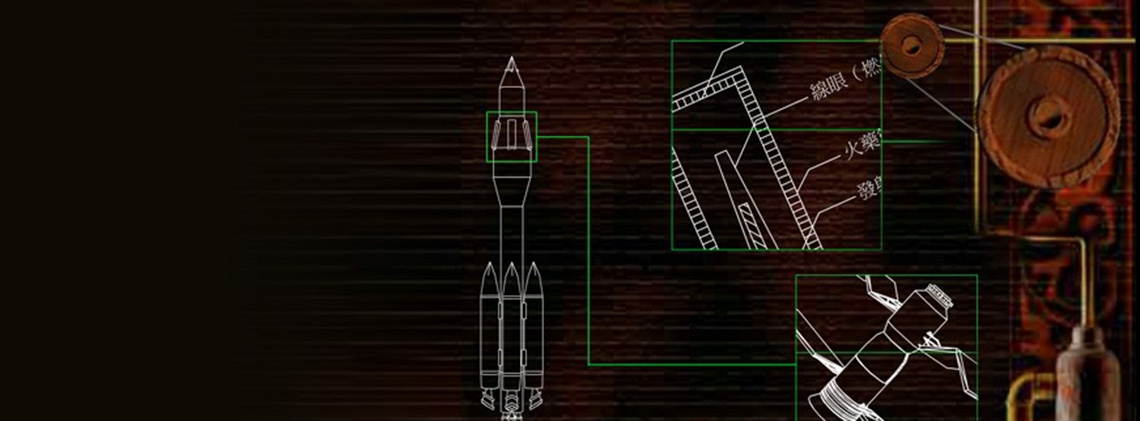
From the Earliest Rocket to Aerospace Science and Technology
Splendid
Chi Culture
Topic
From the Earliest Rocket to Aerospace Science and Technology
Since antiquity, the Chinese have fantasized about roaming the sky. Zhang Hua (232–300) of the Jin dynasty wrote in his Bowu zhi (Notes on a broad array of things) about people from the state of Jigong with one arm and three eyes who could make flying chariots that were capable of roaming the sky. There is also a fourth century reference to the advanced concept of a helicopter top in China.
Modern rockets originated from ancient “fire arrows.” Soon after gunpowder was invented in China, rockets were also invented. Eventually, two-stage rockets were developed, along with a method to recover them. The pre-modern rockets were composed of three components: the rocket cylinder (containing the gunpowder), the shaft, and fuse. In theory, to launch such a rocket one has to release the thermal energy from the combustion chamber, this energy immediately becomes kinetic energy. With the direct counterforce as thrust, the rocket can be launched into the sky. The “flying crow with magic fire” is a winged bomb-carrying missile made of bamboo strips and paper for the body. There was a bird-shaped head at the front, and a tail in the back. Two wings, attached to either side of the body, were used to stabilize the rocket in air. Taken as a whole, it resembled a flying crow. The inside of the “abdomen” was filled with explosives, and four rockets were attached to the body. The cylinder and the explosives were connected to the fuse. Once the fuse was ignited, the crow would fly into the sky and toward the enemy. When the fuel used to launch the rocket was fully consumed, it would ignite the explosives. The rocket could be used either on land or on water.
Not only did the Chinese invent the rocket, they were also the earliest to experiment with rockets carrying humans. During the reign of the Yongle emperor (early fifteenth century), a man named Wan Hu attached forty-seven rockets to a structure to which large kites were attached on either side. A chair was placed in the center of this structure. Wan Hu tied himself to it and ordered his aides to ignite the rockets. The contraption rose up into the sky rapidly and soon disappeared in billowing clouds of smoke. He flew only several hundred meters. Lacking the means to make a safe landing, he crashed and died. In 1970, a crater on the dark side of the moon was named Wan Hu (Wan Hoo) to commend this Ming dynasty pioneer’s contribution to astronautics.
Qian Xuesen (1911–2009) who had been the Robert H. Goddard Professor of Jet Propulsion at Caltech, returned to China in 1955. He established the first guided missile research institute in China, the Fifth Academy of the Chinese Ministry of Defense (renamed the Chinese Academy of Space Technology in 1968). Fifteen years later, China launched its first satellite—Dongfanghong yihao (East is Red No. 1)—on April 24, 1970. Between then and December 2000, China launched forty-eight satellites and one experimental spaceship. On October 15, 2003 at the Jiuquan Satellite Launch Center, China successfully launched its first manned spaceflight, Shenzhou 5, with astronaut Yang Liwei (1965–). Soon afterwards, Shenzhou 6 and 7 were also successfully launched in 2005 and 2008, respectively. On October 24, 2007, China launched its first unmanned lunar-orbiting spacecraft, Chang’e 1, from the Xichang Satellite Launch Center. Six years later, on December 14, Chang’e 3 successfully landed on the moon. On November 1, 2014, Chang’e 5 T1 returned to the earth from the lunar orbit. On September 20, 2015, Changzheng 6, a long range rocket carrying a new satellite, was launched from Taiyuan Satellite Launch Center. It carried twenty small satellites into space. These noteworthy achievements laid the foundation on which the Chinese aerospace dream has been built.



